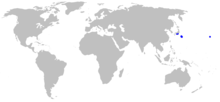| Viper dogfish | |
|---|---|

| |
| Scientific classification | |
| Domain: | Eukaryota |
| Kingdom: | Animalia |
| Phylum: | Chordata |
| Class: | Chondrichthyes |
| Subclass: | Elasmobranchii |
| Order: | Squaliformes |
| Family: | Etmopteridae |
| Genus: | Trigonognathus Mochizuki & Ohe, 1990 |
| Species: | T. kabeyai
|
| Binomial name | |
| Trigonognathus kabeyai | |

| |
| Range of the viper dogfish[2] | |
The viper dogfish or viper shark (Trigonognathus kabeyai) is a rare species of dogfish shark in the family Etmopteridae, and the only extant member of its genus. It has been found in the Pacific Ocean off southern Japan, the Bonin Islands, Pacific Ocean off northern Taitung County and the Northwestern Hawaiian Islands. This species inhabits upper continental slopes and seamounts. It may migrate vertically, shifting between bottom waters 270–360 m (890–1,180 ft) deep during the day and upper waters less than 150 m (490 ft) deep at night. A slender, black shark reaching 54 cm (21 in) in length, the viper dogfish can be recognized by its narrow, triangular jaws and well-spaced, fang-like teeth. It also has two spined dorsal fins, dermal denticles with faceted crowns, and numerous light-emitting photophores concentrated on its ventral surface.
Feeding mainly on bony fishes, the viper dogfish captures prey by protruding its jaws and impaling them with its teeth. Its impressive gape allows it to swallow relatively large fish whole. The skeletal and muscular structure of its head shows unique features that support this feeding mechanism, which is unlike that of other dogfish sharks. This shark gives birth to live young, which are nourished by yolk during gestation; the litter size is probably fewer than 26 pups. Small numbers of viper dogfish are caught incidentally in purse seines and bottom trawls.
- ^ Rigby, C.L.; Ebert, D.A.; Herman, K. (2020). "Trigonognathus kabeyai". IUCN Red List of Threatened Species. 2020: e.T44205A80678455. doi:10.2305/IUCN.UK.2020-3.RLTS.T44205A80678455.en. Retrieved 19 November 2021.
- ^ Cite error: The named reference
yano et alwas invoked but never defined (see the help page).
